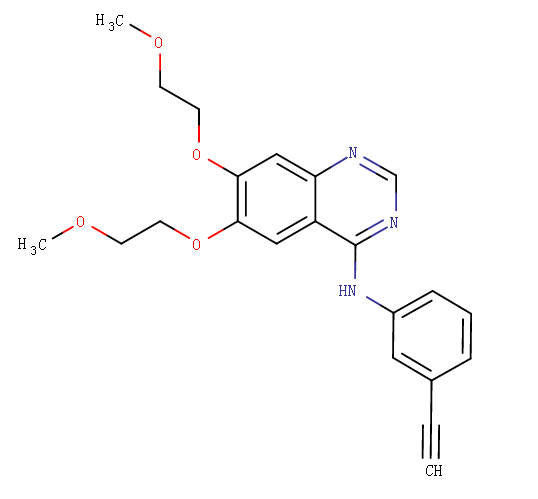Erlotinib
Other name
-
International/Other brands
Tarceva
Groups
Approved
Structure

Prescription products
| Name | Dosage | Strength | Route | Labeller |
|---|---|---|---|---|
| PMS-erlotinib | Tablet | 150 mg | Oral | Pharmascience Inc |
| PMS-erlotinib | Tablet | 100 mg | Oral | Pharmascience Inc |
| Tarceva | Tablet | 25 mg/1 | Oral | Physicians Total Care, Inc. |
| Tarceva | Tablet | 100 mg/1 | Oral | Genentech, Inc. |
| Tarceva | Tablet | 100 mg | Oral | Hoffmann La Roche |
| Tarceva | Tablet | 100 mg/1 | Oral | Physicians Total Care, Inc. |
| Tarceva | Tablet, film coated | 100 mg | Oral | Roche Registration Limited |
| Tarceva | Tablet | 25 mg | Oral | Hoffmann La Roche |
| Tarceva | Tablet | 25 mg/1 | Oral | Genentech, Inc. |
| Tarceva | Tablet | 150 mg/1 | Oral | Physicians Total Care, Inc. |
Target
EGFR, NR1I2
Description
Erlotinib hydrochloride (trade name Tarceva, Genentech/OSIP, originally coded as OSI-774) is a drug used to treat non-small cell lung cancer, pancreatic cancer and several other types of cancer. Similar to gefitinib, erlotinib specifically targets the epidermal growth factor receptor (EGFR) tyrosine kinase. It binds in a reversible fashion to the adenosine triphosphate (ATP) binding site of the receptor. Erlotinib has recently been shown to be a potent inhibitor of JAK2V617F activity. JAK2V617F is a mutant of tyrosine kinase JAK2, is found in most patients with polycythemia vera (PV) and a substantial proportion of patients with idiopathic myelofibrosis or essential thrombocythemia. The study suggests that erlotinib may be used for treatment of JAK2V617F-positive PV and other myeloproliferative disorders.
Indications
Locally Advanced Non-Small Cell Lung Cancer, Locally Advanced Pancreatic Cancer, Lung Cancer Non-Small Cell Cancer (NSCLC), Metastatic Non-Small Cell Lung Cancer, Pancreatic Cancer Metastatic
Other indications
-
Mechaism of action
-
Absorption
Erlotinib is about 60% absorbed after oral administration and its bioavailability is substantially increased by food to almost 100%. Peak plasma levels occur 4 hours after dosing. The solubility of erlotinib is pH dependent. Solubility decreases pH increases. Smoking also decrease the exposure of erlotinib.
Metabolism
Metabolism occurs in the liver. In vitro assays of cytochrome P450 metabolism showed that erlotinib is metabolized primarily by CYP3A4 and to a lesser extent by CYP1A2, and the extrahepatic isoform CYP1A1.
Toxicity
Symptoms of overdose include diarrhea, rash, and liver transaminase elevation. The most common adverse reactions (>50%) in NSCLC are rash, diarrhea, anorexia and fatigue. The most common adverse reactions (>50%) in pancreatic cancer are fatigue, rash, nausea and anorexia.